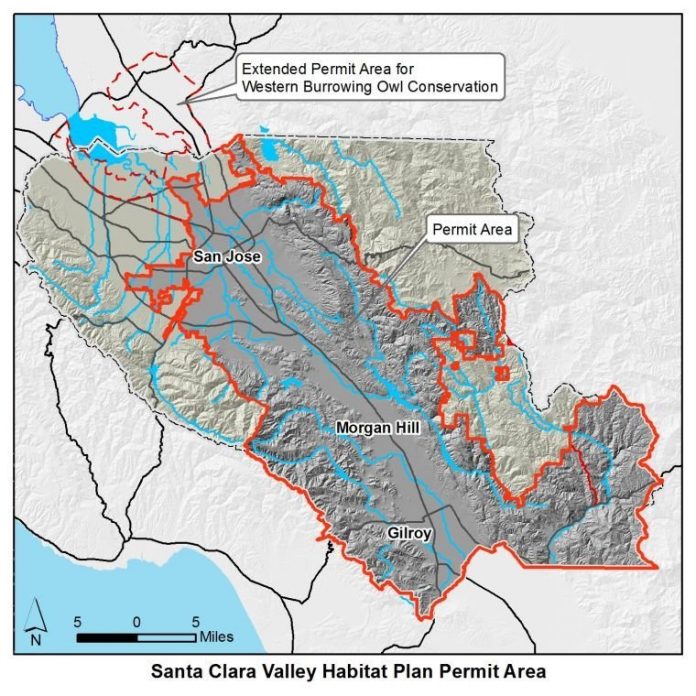Santa Clara County is stepping up efforts to support restoration and conservation projects through collaborative efforts from a number of local, state and federal agencies.
One such effort is being led by the Santa Clara Valley Habitat Agency, which held a ceremony Oct. 3 atop Anderson Dam in Morgan Hill to mark the signing and launch of the Santa Clara Valley Habitat Plan: A sweeping, multi-agency regional plan spanning 50 years and designed to protect open space, identify land occupied by endangered or threatened species and streamline the permitting/development process.
The dam was a fitting location, not only because it provided a view of much of the 46,920 acre area covered by the Habitat Plan, but also because the multi-year Anderson Dam Seismic Retrofit is among the near-term public projects with the potential to be streamlined as a result of the plan.
The Santa Clara Valley Habitat Agency is a Joint Powers Authority formed to implement the Habitat Plan. The Habitat Agency is composed of the cities of Gilroy, Morgan Hill and San José, and the County of Santa Clara. The Santa Clara Valley Transportation Authority and the Santa Clara Valley Water District are Habitat Agency co-permittees. In this role they also work with U.S. Fish and Wildlife Services and the California Department of Fish and Wildlife, the two agencies responsible for applicable state and federal laws pertaining to endangered species.
Leading the event’s guest speaker lineup was Santa Clara County Supervisor Mike Wasserman. When asked what the biggest challenge of the Habitat Agency might be, he replied, “Making the dream a reality. It’s a win-win for developers and for environmentalists. In the past, project permitting might involve many separate agency visits and take six to nine months. This is about being able to walk into one office, fill out one permit, and write one check. Now, very quickly, projects can move forward.”
Morgan Hill Mayor Steve Tate told attendees he is proud of the Habitat Agency’s efforts and delighted that its base of operations will be established at the former Morgan Hill City Hall location, which is currently being refurbished.
The Habitat Plan is considered a habitat conservation plan under Federal law, and a natural community conservation plan under California state law.
The plan’s stated objectives are to:
-Help private and public entities plan and conduct projects and activities in ways that lessen impacts on natural resources, including specific threatened and endangered species.
−Identify regional lands, also referred to as reserves, to be preserved or restored to benefit those species.
-Describe how reserves will be managed and monitored to ensure that they benefit those species.
−Enhance the viability of threatened and endangered species of the Santa Clara Valley through a long-term, coordinated program for habitat restoration and conservation.
The original agreement to develop a Habitat Plan was signed by Habitat Agency stakeholders in 2005. Plan specifics include protection of native wildlife species such as the Western Burrowing Owl, San Joaquin Kit Fox and Bay Checkerspot Butterfly; native plant species including the Tiburon Indian Paintbrush, Fragrant Fritillary and Coyote Ceanothus; and wetland areas.
Proposed Habitat Plan Benefits
−For landowners wishing to develop land, the Habitat Plan streamlines the permitting process by pre-identifying mitigation obligations.
−For private developers and public agencies, the Habitat Plan offers a streamlined process for planned development, infrastructure, operations and maintenance activities.
−For the environment, the Habitat Plan protects, enhances and restores natural resources in specific areas of Santa Clara County and contributes to the recovery of threatened and endangered species.
In his remarks to attendees, Santa Clara Valley Water District Director Dennis Kennedy said the “the Anderson Dam Seismic Retrofit is vital for our water supply and to those who live and work in the shadow of this dam, which was built more than 50 years ago”.
Kennedy pointed out the Habitat Plan would enable “swift permit clearances to start the project” without “lengthy approval processes”.
Other guest speakers at the ceremony included Gilroy Mayor Don Gage, San José City Councilmember and VTA Board Vice Chair Ash Kalra, San José City Councilmember and VTA Board Director Rose Herrera, and San José City Councilmember Pierluigi Oliverio.
The Habitat Plan permit term is 50 years. At full plan implementation, an estimated 46,920 acres or 73 square miles of Santa Clara County will be permanently protected under the plan’s reserve system.
According to Habitat Agency information, the Habitat Plan is not a land use plan and does not change or amend any local jurisdiction’s policies regarding zoning or allowable growth.
Large tracts of land, from the Santa Clara County/Alameda County border south to the county’s boundary with San Benito County, and from the western edge of San Jose east to the crest of the Diablo Range, may be included in the plan.
The Habitat Agency will establish and collect plan development fees from co-permittees, private developers and other local entities to fund the share of Habitat Plan costs related to mitigating urban and rural development, the construction and maintenance of public infrastructure, conservation commitments, and other covered activities.
“This plan is a gold standard among habitat conservation plans,” said Scott Wilson of the California Department of Fish & Wildlife. “It’s an amazing balance between promoting economic growth and conservation of diverse lands and wildlife species.”
According to the Habitat Agency’s current Executive Officer, Ken Schreiber, “We’re making great progress establishing policies and procedures, identifying the highest priorities for conservation and adding them into the budget.”
The Habitat Agency is also looking for a full-time director, and when asked about the job qualifications, Schreiber pointed at the Anderson Reservoir and said jokingly, “He might have to walk on water.”
The Habitat Agency has formed a Public Advisory Committee to solicit input from stakeholders and hold an annual meeting to report on its progress. Its Governing Board and Implementation Board meetings are also open to the public. More information is available online here.











